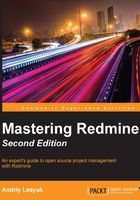
What this book covers
Chapter 1, Getting Familiar with Redmine, prepares us for the next chapters by briefly going through the concept of the Redmine interface and reviewing replaceable components of the application.
Chapter 2, Installing Redmine, includes detailed instructions on how to install Redmine in two different ways, each of which is preferable for different purposes. Additionally, it mentions some other ways to easily install Redmine.
Chapter 3, Configuring Redmine, reviews the configuration options, which are available on the Settings page in the Administration menu, and covers the advanced options that are concealed behind them. Also, this chapter contains a section that describes how to troubleshoot problems in the application.
Chapter 4, Issue Tracking, reviews what makes Redmine one of the best issue trackers, also paying heed to the configuration options that are related to issue tracking.
Chapter 5, Managing Projects, covers the major part of Redmine functionality, which is related to projects, and demonstrates why this is one of the best applications for project hosting.
Chapter 6, Text Formatting, is a comprehensive tutorial for the Redmine rich text formatting syntax, which is used all over Redmine. This chapter mainly describes Textile (one of the supported markup languages), at the same time mentioning analogs in Markdown.
Chapter 7, Access Control and Workflow, is aimed at enlightening the permission system and the issue life cycle by explaining what the role, tracker, and issue status are and how they are connected.
Chapter 8, Time Tracking, describes the time tracking capabilities of Redmine and shows how to work with time reports.
Chapter 9, Personalization, will help you make Redmine more comfortable for yourself and ensure that you'll be notified about events that are important or interesting for you. Additionally, this chapter describes how third-party user accounts can be used to access Redmine.
Chapter 10, Plugins and Themes, guides the readers to find plugins for a particular version of Redmine, covers installation of plugins and themes, and reviews some plugins and themes.
Chapter 11, Customizing Redmine, shows the power of custom fields and shows how to customize Redmine without breaking upgrade compatibility. In particular, this chapter explains how to create a simple theme and plugin.
Appendix, Quick Syntax Reference, contains a brief list of syntax rules that are supported by Redmine's Wiki syntax. This reference includes the syntax rules of Textile and Markdown.